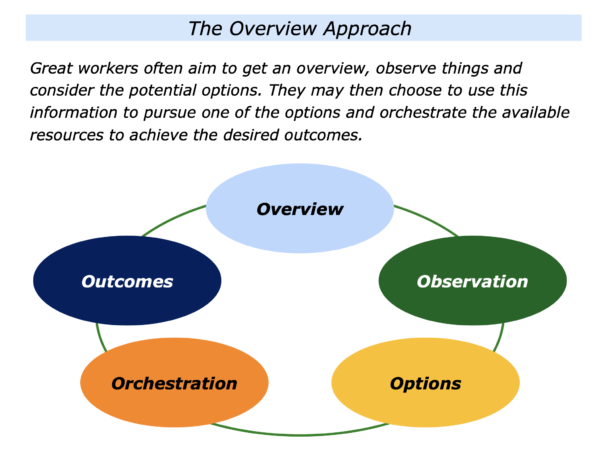
Great workers are good at getting an overview of events in their area of expertise. They aim to gather information, observe things and see the big picture. They then explore the potential options for going forwards.
Such workers may choose to pursue one of the options and translate their chosen strategy into action. They may then aim to orchestrate the available resources to achieve the desired outcomes.
Great workers sometimes do this by themselves. Sometimes they take a leadership role. They then employ coordinators and experts to do superb work and achieve success.
Let’s consider some of the steps that such people take to pursue these themes.
Overview
Great workers quickly get an overview of the situation in the specific activities where they excel. They like to gather information, get the big picture and see how things are connected.
Such workers aim to clarify what is happening and consider the potential options for going forwards before then forming an opinion. They take this approach even they may have strong opinions.
Some other people may immediately revert to their opinions. They take that approach rather than getting an overview and exploring the potential options.
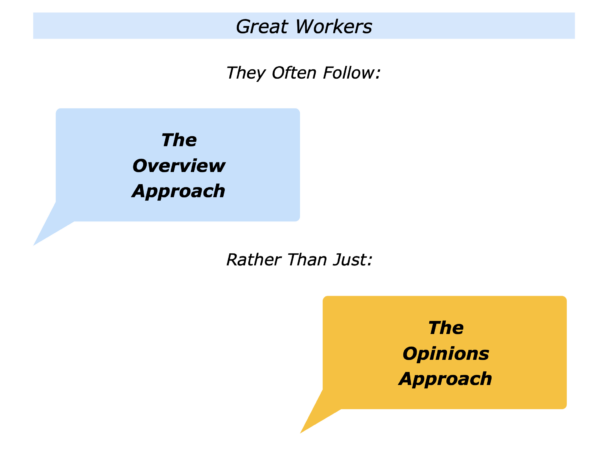
Observation
Great workers get an overview by gathering information and also observing what is happening. Such people do this by taking the following steps.
They aim to observe what is actually happening – such as what the people are doing or the actual events that are happening;
They aim to see patterns – both the potentially successful and unsuccessful patterns;
They aim to make sense of what is happening – plus what may potentially happen in the future.
Such workers sometimes seem to hover above a situation and also see things from different angles. Advisors who are asked to help organisations, for example, may aim to look from the outside to see what is happening. This can help them to see patterns.
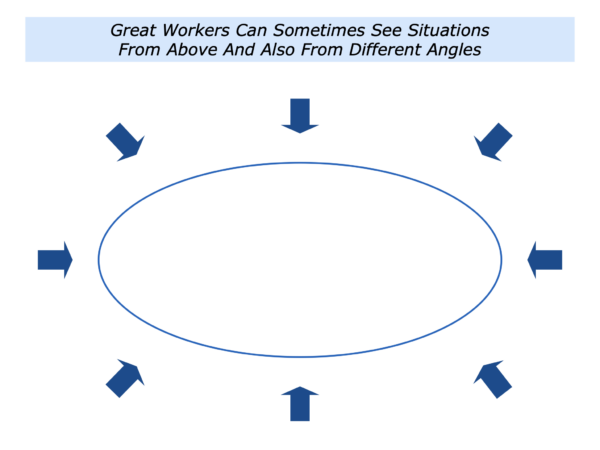
Options
Great workers observe what is happening. If appropriate, they then clarify the potential options for going forwards. They also clarify the pluses and minuses of each option.
Different workers do this in different situations. They may do it when in some of the following situations.
They may be aiming to make a particular decision;
They may be aiming to achieve a particular goal;
They may be aiming to provide other decision makers with potential options for achieving a particular goal.
Such workers go through a certain process when making decisions. They may take the following approach.
Distancing
Great workers are highly sensitive to what may be happening in their chosen field. Bearing this in mind, they aim to manage their emotions. They may do this when making a tough decision, tackling a crisis or managing a challenge.
Different people employ different ways to distance themselves. One approach is to almost helicopter above the situation. They then aim to get an overview and see the possible options for going forwards.
Another approach is to drain themselves of emotion. Some people become calm, clear and consider their options. They may then demonstrate what is called cold courage when moving into action.
Distancing can be crucial to make considered decisions but this comes with a caveat. It is also important to recognise that the decision they take will affect both their own and other people’s emotions.
Desired Results
Great workers begin to focus on the desired results. When appropriate, they may employ the classic questions for clarifying the goals. These include the following.
What is happening in the situation? What are the real results we want to achieve? What is the picture of success? What will be the benefits of achieving these goals? What will be happening that will show we have achieve the picture of success?
Good decision makers take time to get a deep understanding of the situation, the options and the implications. Daniel Forrester encourages people to take this approach before making decisions.
He explains this approach in his book Consider: Harnessing the power of reflective thinking in your organization. Here is some background from Daniel’s website.
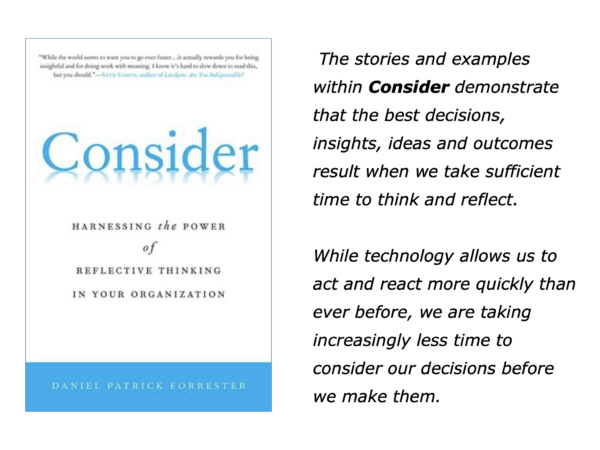
Consider
This original work distilled the lessons in leadership and habits of reflective thinking that made the difference within the recent financial crisis, war in Iraq and in recovering from the oil spill in the Gulf of Mexico.
“STOP, THINK, AND DON’T DO SOMETHING STUPID!”
This is the warning Dr. Robert Bea drills into his Civil and Environmental Engineering students at the University of California in Berkeley.
Bea wants to dramatize what he terms the inevitable “oh shit” moments that present themselves-before an actual engineering calamity like the Deepwater Horizon/BP disaster happens.
Reflection supplies an arsenal of ideas and solutions to the right problems.
Forrester shows us that taking time and giving ourselves the mental space for reflection can mean the difference between total success and total failure.
Different Options
Great workers may brainstorm the possible options together with the pluses and minuses of each option. They may also consider the attractiveness rating of each route.
Such a worker who has been asked to advice other decision makers, for example, may simply outline the options and the implications. They may then present these to the decision makers.
Great workers who are focusing on their own piece of work may settle on their chosen route. There may be times, of course, when they combine elements of the various options to create a new route.
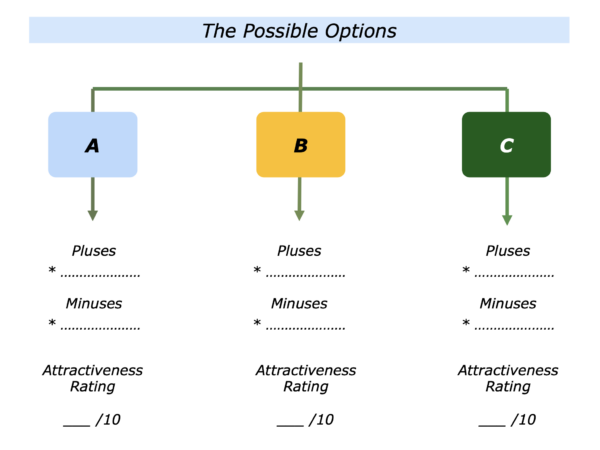
Orchestration
Great workers sometimes want to go beyond getting an overview of a situation. They want to translate this awareness into achieving results.
Different people do this in different ways. One common factor, however, is that they often orchestrate the available resources to achieve the goals.
They may orchestrate their own resources – their spirit, strengths and strategic thinking – to achieve success;
They may orchestrate the resources of their team or organisation to achieve success;
They may orchestrate certain resources in society to achieve success.
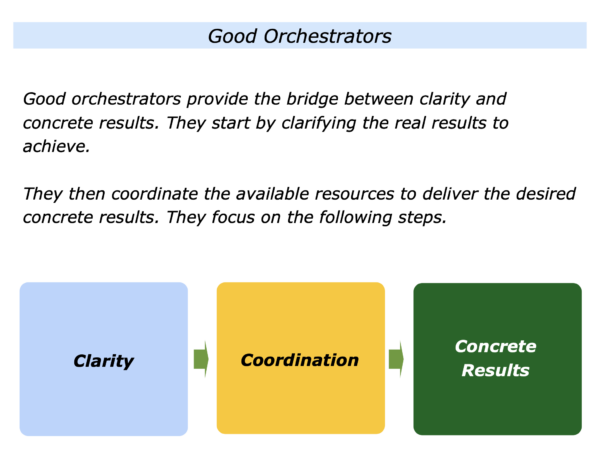
Good orchestrators follow the guidelines described earlier in the article on The Coordination Approach. Bearing this in mind, here is a brief overview. Such people often ask the following questions.
What are the real results we want to achieve? What are the actual words we would like to hear the various stakeholders saying about what we deliver? What is the picture of success?
What are the various resources we have available? How can we coordinate people’s strengths and the other resources to deliver the results? How can we give people the required support?
How can we enable people to do superb work? How can we anticipate and find solutions to challenges? How can we keep improving and do our best to deliver the picture of success?
You may or may not be good at coordinating things. Bearing this in mind, you may sometimes need to get help in this area.
Good leaders, for example, build on their strengths. They may be good at communicating the organisation’s purpose, principles and picture of success. They may also be good at working with customers and managing their backers.
Such leaders may then work with people who have complementary strengths. These often include coordinators who make sure that things get done.
Let’s return to your own work. What is the kind of situation where you are good at getting the overview and orchestrating the resources to deliver the desired outcomes?
Sometimes you may do these tasks yourself. Sometimes you may complement your strengths by working with people who have other skills. What do you do then to make sure the goods are delivered?
Outcomes
Great workers deliver the desired outcomes. They may do this in their work as an educator, carer, social entrepreneur, sports coach, scientist, leader or in another role.
Dr Govindappa Venkataswamy was somebody who took this route. Known as Dr V., he dedicated his life to providing people with the gift of sight. His individual work and the founding of the Aravind Eye Hospitals has led to helping millions of people to see.
He believed in the following philosophy. Here is an introduction to Dr V’s work. This is based on an article by David Kemer in which he cites the doctor as his hero.
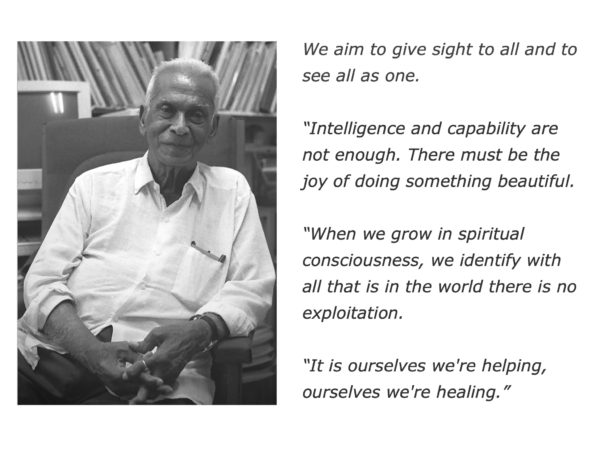
Dr V. was born in 1918 to a farming family in South India. He gained a medical degree, planned to practice obstetrics but then experienced a setback. Contracting rheumatoid arthritis which affected his hands, he decided to change field. David Kemer describes what Dr V. did next.
He began studying ophthalmology and had instruments specially designed for his arthritic hands – each one custom-made to fill a specific need.
These instruments enabled him to perform as many as 100 cataract surgeries a day. He quickly became the most admired cataract surgeon in India.
Dr V. performed eye surgeries at this rate for 25 years before exploring how to scale his approach. Inspired by the McDonald’s approach to selling burgers, he aimed to provide millions of sight-restoring operations.
This led to setting up the Aravind Eye Hospital. This had 11 beds in a rented house in Madurai, India. David Kemer describes what has happened since.
Today, there are some 3600 beds in five Aravind Eye Hospitals that perform more than 200,000 operations each year. And 70% of the patients pay little or nothing.
Hundreds of thousands of India’s poor have been granted the gift of sight. Dr V. lowered the cost of cataract operations to nearly $10 per surgery compared to almost $1650 in the U.S.
He reorganized how cataract surgeries are done. By training a team of paramedicals to do 70% of the work required in each surgery, doctors are freed up to do a great many more of them.
All of the treatments performed at Aravind Eye Hospitals are financed by those patients who are most able to afford them – roughly 30% – who seek out Aravind’s world-renowned quality and happily pay competitive prices.
As such, Aravind Hospitals have become a business model for health care systems the world over.
Dr V. created a wonderful legacy. The Aravind Hospital’s philosophy has been described in the following way.
Each year they bring light to millions of lives. If people can’t pay, they don’t have to. If people can’t go to the hospitals, the medical care goes to them.
Aravind’s vision is to eliminate needless blindness. Their services are world-class, but the spirit that drives them is one of a kind. It is to provide compassionate and quality eye care affordable to all.
Let’s return to your own life and work. Looking ahead, can you think of a situation where you may want to follow elements of the overview approach? How can you do this in your own way?
If you wish, try tackling the final exercise on this theme. This invites you to complete the following sentences.
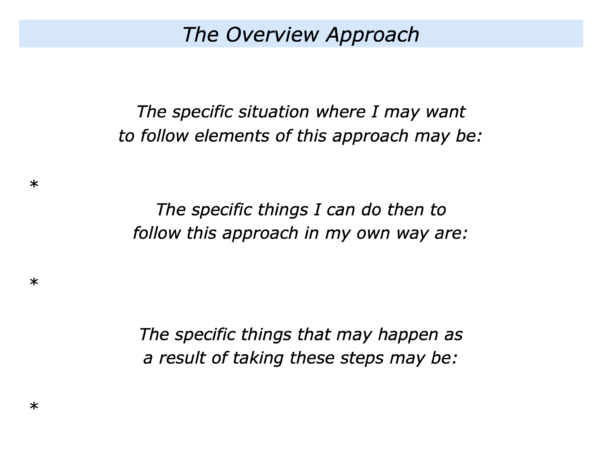






Leave a Reply